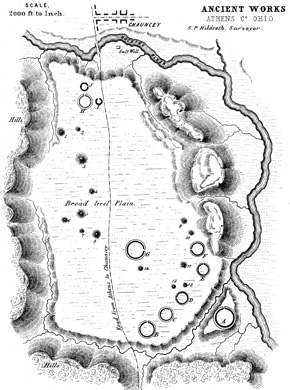HARTMAN AND
WOODRUFF-CONNETT MOUNDS
ATHENS, HOCKING VALLEY
ATHENS, HOCKING VALLEY
HARTMAN AND
WOODRUFF-CONNETT MOUNDS
The largest of the remaining mounds in The Plains, the Hartman Mound, stands 40 feet high, and 140 feet in diameter. Going north on SR 682, turn left on Mound Street (confirm this) for about one quarter mile.
It has never been excavated, although probably contains graves similar to the one found, during the nineteenth century, in a smaller mound nearby: there, a log tomb held the deceased, surrounded by five-hundred rolled copper beads, and a tubular pipe.
Although there is an implied pathway, climbing is not encouraged, out of respect for both the ancient graves and the private landowner.
Follow Mound Street or the Adena Drive loop to reach the smaller, nearby Woodruff-Connett Mound, the largest of what was once a cluster of three. It stands 15 feet high, with a base diameter of 90 feet, and is now mostly tree-covered. Along part of the base you can see a slightly elevated “apron” of earth, which may belong to the ancient design. The mound sits on land preserved as open space by the Athens County Historical Society and Museum. Look for a slight swell in the grass nearby, where a second mound once stood, about half the size of this one.
Ongoing research reveals that the people who built the great circles and mounds of The Plains lived along the terraces of the surrounding hills. They also built small mounds on the peaks of the hills using earth and stone. When they descended to the sacred plain below, their purpose seemed to be to join with others in building and using the large earthworks – gatherings that probably combined commercial, civic, social, funerary, and spiritual importance.
Dr. Elliot Abrams, an archaeologist at Ohio University, studied the Armitage Mound nearby as it was being destroyed for a housing project in 1987. He found a central burial of a man in his 50’s, surrounded by 14 cremated burials – perhaps a sign of social hierarchy. About 40 small shallow fire pits at various levels suggested people revisited the mound at intervals, burning substances and adding soil to the mound over perhaps four to six generations. This suggested to Abrams an association of families or groups living in the hills around The Plains, who gathered to honor the central figure, bringing their already-cremated ancestors together here. Bladelets in the fill show that these people had connections with the Middle Woodland (Hopewell) tradition, although in this valley the earlier Adena era practices continued to dominate.
Take SR 550 from Athens to Marietta, exploring its mining and forest history in one of several podcasts, featuring interviews with locals and available online from the Athens County Visitors Bureau: http://www.athensohio.com/tours/athens-county-tour.

The Plains offers a prime example of the earth-building and settlement traditions that archaeologists call “Adena” (Squier and Davis).